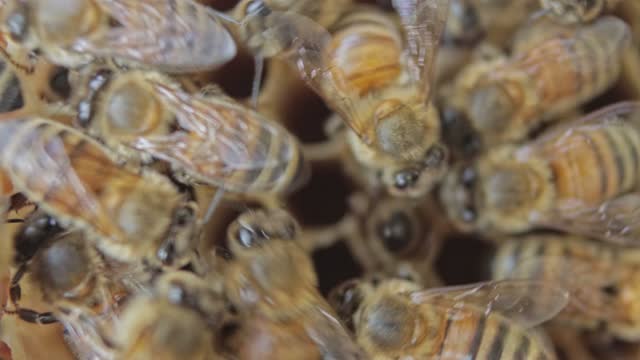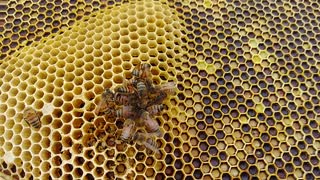Premium Only Content

bees in a honeycomb
bees in a honeycomb
Bees are insects with wings closely related to wasps and ants, known for their role in pollination and, in the case of the best-known bee species, the western honey bee, for producing honey. Bees are a monophyletic lineage within the superfamily Apoidea. They are presently considered a clade, called Anthophila. There are over 16,000 known species of bees in seven recognized biological families.[1][2] Some species – including honey bees, bumblebees, and stingless bees – live socially in colonies while most species (>90%) – including mason bees, carpenter bees, leafcutter bees, and sweat bees – are solitary.
Bees are found on every continent except for Antarctica, in every habitat on the planet that contains insect-pollinated flowering plants. The most common bees in the Northern Hemisphere are the Halictidae, or sweat bees, but they are small and often mistaken for wasps or flies. Bees range in size from tiny stingless bee species, whose workers are less than 2 millimetres (0.08 in) long,[3] to Megachile pluto, the largest species of leafcutter bee, whose females can attain a length of 39 millimetres (1.54 in).
Bees feed on nectar and pollen, the former primarily as an energy source and the latter primarily for protein and other nutrients. Most pollen is used as food for their larvae. Vertebrate predators of bees include primates and birds such as bee-eaters; insect predators include beewolves and dragonflies.
Bee pollination is important both ecologically and commercially, and the decline in wild bees has increased the value of pollination by commercially managed hives of honey bees. The analysis of 353 wild bee and hoverfly species across Britain from 1980 to 2013 found the insects have been lost from a quarter of the places they inhabited in 1980.[4]
Human beekeeping or apiculture (meliponiculture for stingless bees) has been practised for millennia, since at least the times of Ancient Egypt and Ancient Greece. Bees have appeared in mythology and folklore, through all phases of art and literature from ancient times to the present day, although primarily focused in the Northern Hemisphere where beekeeping is far more common. In Mesoamerica, the Mayans have practiced large-scale intensive meliponiculture since pre-Columbian times.[3]
-
 0:23
0:23
Country Girl Videos
3 years ago $0.07 earnedHoney Bees Cleaning Honeycomb
13535 -
 0:45
0:45
OceanParadise
4 years ago $0.08 earnedAsmr eating honeycomb
118 -
 5:13
5:13
Walaasaid001
3 years agoMake your Own Paper Honeycomb Ball
12 -
 5:13
5:13
kontributor
3 years agoHow to make a paper honeycomb ball DIY
761 -
 18:37
18:37
Clownfish TV
6 hours agoThe Oscars Just EMBARASSED Disney and Emilia Pérez...
54.7K24 -
 56:28
56:28
Glenn Greenwald
8 hours agoDocumentary Exposing Repression in West Bank Wins at Oscars; Free Speech Lawyer Jenin Younes on Double Standards for Israel's Critics | SYSTEM UPDATE #416
101K83 -
 1:03:34
1:03:34
Donald Trump Jr.
10 hours agoZelensky Overplays His Hand, More Trump Wins, Plus Interview with Joe Bastardi | Triggered Ep.221
160K131 -
 1:13:16
1:13:16
We Like Shooting
19 hours ago $5.56 earnedDouble Tap 399 (Gun Podcast)
52.8K2 -
 1:00:20
1:00:20
The Tom Renz Show
1 day agoTrump Schools Zelensky, The Epstein Files FAIL, & What RFK Will Mean for Cancer
54.9K22 -
 42:47
42:47
Kimberly Guilfoyle
12 hours agoThe Trump effect: More Major Investment, Plus America First at Home & Abroad. Live w/Ned Ryun & Brett Tolman | Ep. 201
136K43